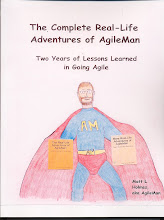Vicki wanted to go first, and so she took up the first forty-five minutes (of a 3-hour class) describing several of the jobs that she's had over the years that didn't, at first glance, appear to be related to Project Management... and yet were! The overall message of her talk was that there are more types of PM jobs out there than you might think, and the students seemed both interested and encouraged to hear that viewpoint! Although she was nervous going in, you'd never have known it to watch her... and she's now much more confident of her own ability to present on that topic.
My portion of the proceedings ended up taking close to 2 hours, in part because I had more material to cover (more on that in a moment) but also because I got asked a lot of questions! Although a handful of the inquiries were slightly skeptical in nature ("Could you really get a customer to approve spending money if you're not promising to deliver on time?"), most were more obviously related to them beginning to connect the dots. Which leads nicely into what my talk was on.
I broke it into 2 parts: What is Agile?, and What do PMs do in an Agile world? Because I had to assume that they had no knowledge of Agile prior to this (which turned out to be mostly accurate), it seemed critical to me when I was planning my lecture to give them a sufficient grounding in it before moving on to the Project Management angle. Based on how things proceeded, I'd say that was a wise choice.
Because it was a PM course, and I'd taken a look at their curriculum online, I decided that it was appropriate to frame Agile within the context of how common it is (and has been, for decades) for software projects to fail... a topic that I knew they were well familiar with. I provided some ideas of my own as to why the failure rate has always been so high, and then showed how - if done properly - Agile might address some of those factors. An actual PM from my former job was in the audience, and was nice enough to offer up some good observations to the class about areas where Agile had actually helped.
Before I moved into the second half of the material, I decided to get everyone up off their butts in a goofy little move where I had them stand up and give me an enthusiastic "but but but" as I launched into some of the more obvious reasons why Agile, as I'd described it up to that point, might seem like pure poison to a group of project management enthusiasts. You never know how that sort of thing is going to fly, but at least they played along and it kept them having to sit still for the entirety of the 2 hours!
I had 8 aspects of Project Management that I discussed, in turn, showing how a PM would add value in an Agile organization while doing the role in a manner different than what they might expect:
- Requirements Gathering
- Task Estimation and Tracking
- Project Planning
- Personnel "Management"
- Quality Assurance
- Customer Relations
- Status Reporting & Milestones
- Scope Management
Both of our presentations appeared to go over very well, and we came away feeling as if we'd done a good job. Those of you who know people in the course are free to seek out differing opinions, though!





No comments:
Post a Comment